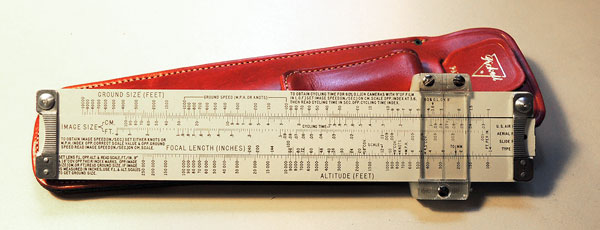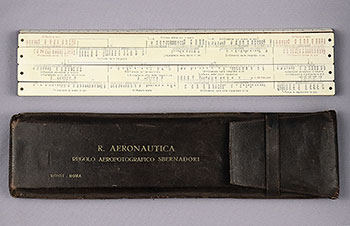 Up
Up
|
|

|

|
Sbernadori’s aerophotographical slide rule |
|
|
|
|
 Click photo to enlarge |
|
|
|
This large slide rule, the “Regolo
aerofotografico Sbernadori”, helps you plan aerial photography
flights. It computes, given the flight height, speed, plate (i.e.
film) size and lens focal length, how to time the photo shooting to
ensure proper coverage of the desired land area. It also helps you
convert distances on the photo, on a topographic map, and on the
actual terrain. Aerial reconnaissance is a useful military art, and there were a variety of slide rules directed at this task, like the American one seen in the photo below. There is also my rare “Cornell F.24 photographic calculator”, described here, which achieves the same goal in a very different form factor. |
|
|
|
 The Pickett N700-T US Air Force Aerial Photo Slide Rule Click photo to enlarge |
|
|
|
The Sbernadori stands out in this class of slide rules because it has two slides rather than one, which allows complicated calculations to be concatenated in a sequence from slide to slide. The detailed instructions on the back of the rule are quite helpful… if you read Italian, that is. |
|
|
|
 Click photo to enlarge |
|
|
|
Here is a translation: For problems dealing with only one photograph, move only the upper slide. Bring the value of F (focal distance) against the value of Q (altitude of the aircraft). Following the upper arrows you will find at the same time:
You can operate in the opposite direction to obtain Q (or one of the other data) knowing F, Sf, C, L, and Dt. For problems involving a series of photographs, after effecting the previous operation move the lower slide to:
The three operations can be reversed to obtain the intermediate data of the problem. To find out the minimum exposure time needed to keep the Image Definition ε within the limits of 1/10 to 1/30 of a millimeter, move both slides.
You can reverse the operation to obtain Q or V knowing the other data. You can get an idea of the
geometry involved from the diagram in
my article about the Cornell F.24 calculator, whose purpose
overlaps the Sbernadori’s to a large extent. Just keep in mind that
some variable names are different due to the different language
used. |
|
|
|
Well, now that I had a first name I could
search the web and find several mentions of a Paolo Sbernadori, born
in 1894, who had both an Engineering degree and a long career in
aviation, from securing a pilot license in 1915 to retirement as an
Air Brigadier General in 1967. In between, he served in the Italian
air force in two world wars, and held a variety of positions,
including Air Attaché to the Royal Italian Embassy in Washington DC
in the 1930s. I also found a journal from 1948 that ascribes to him
the invention of the petroleum slide rule. Putting all these
snippets together we can be pretty certain that the inventor of the
slide rule I have is this same engineer and aviator, Paolo
Sbernadori. Here he is in the photo. One last tidbit: we see in this state publication that in 1954 the Italian certification exams for aerial photographers included demonstration of proficiency on both the Sbernadori and Giovine slide rules (I also have Giovine’s slide rule in my collection… maybe I’ll write it up someday). So we know that the Sbernadori slide rule was looked on with favor in the Italian military. Looks like the same can be said of Paolo Sbernadori himself, given a career that spanned over half a century of aviation! |
 Click photo to enlarge |
|
|
|
Exhibit provenance: Bought this from a collector in Italy. More info: |
|
|
|
|
|
|
|
Home | HOC | Fractals | Miscellany | About | Contact Copyright © 2024 N. Zeldes. All rights reserved. |
|
